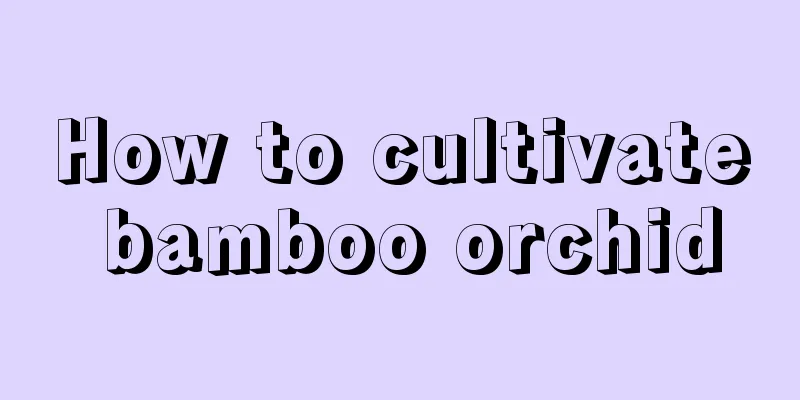How to cultivate bamboo orchid

1. Maintenance methods1. Temperature: The most suitable range is between 15 and 30 degrees. If it is above 35 degrees, its growth will be hindered to a certain extent. In addition, it is not very cold-resistant. It is best to keep it indoors during the winter, and the minimum temperature should not be lower than five degrees. If it is grown in the north and left outdoors in winter, it will drop its leaves due to the cold. 2. Light: Bamboo leaf orchid is a shade-loving plant and does not like strong light. Excessive strong sunlight can cause great harm to it. Even if it only stays in a place with strong sunlight for one or two days, its leaves will be burned or even scorched. Therefore, it is best to place it in a cool place away from strong light. However, there is no shading in winter. 3. Watering: Because its roots are fleshy, it is very afraid of waterlogging. Generally speaking, you can keep it at "80% dry and 20% wet", and never allow water to accumulate. 4. Fertilization: Fertilize bamboo orchid mainly with foliar fertilizer. Generally speaking, the effect is better if it is applied once every ten days. 2. Breeding techniques1. Reproduction: Division is commonly used. Generally speaking, a plant can be divided once every three years. Choose a strong plant with many pseudobulbs as the mother plant. When dividing it into several parts, be sure to keep a certain amount of bulbs in each part. After planting, they need to be watered thoroughly and then placed in a cool place for ten to fifteen days. 2. Repotting: once a year or once every two years. Try once a year. You can use nutritious and slightly acidic soil such as leaf mold. In addition, not only do you need to change the soil, you also need to clean the roots, repair them, and then pot them. 3. Problem diagnosis and treatment1. Disease: "White rot" occurs quite frequently, especially during the rainy season. After it occurs, lime can be used to prevent and control it. When the temperature is high and there is a lot of rain, anthrax is prone to occur. It can be treated with methyl thiophanate once a week. 2. Pests: Mainly "orchid lice" and other types, which can be controlled by using omethoate solution. IV. Other issues1. Toxicity: It is a poisonous species, but it is fine as long as it is not accidentally ingested. 2. Can it be raised at home: It is suitable and has high ornamental value. Moreover, experts have recently bred a very small variety that is only fifteen centimeters tall, which is very suitable for placing at home. |
<<: Cultivation method of cinnabar root
Recommend
When to plant American dianthus
time If possible, we generally plant it in spring...
Complete list of cornflower varieties
Cineraria Dwarf Cornflower Cornflower Eurasian Co...
How to plant Chinese cabbage? Planting methods and management techniques
Growing environment requirements for Chinese cabb...
How to grow Oyster Mushroom to get high yield?
Oyster mushroom is a popular edible fungus belong...
The efficacy and function of Wasson
effect The stonecrop is the whole herb of the Cra...
What is the plant Azolla
1. What is Azolla? Azolla is a small floating pla...
What is the best way to grow navel orange seedlings in southern Jiangxi?
Gannan navel orange is world-famous for its large...
How to make spider plants colorful in wedding oil painting
Wedding Oil Painting Chlorophytum Conditions Afte...
Spring Horse Beheading Method
1. Prepare tools Before beheading the spring ju, ...
Can vermiculite be used to grow succulents?
Can vermiculite be used to grow succulents? Vermi...
How to prune hibiscus
How to prune hibiscus branches and leaves Because...
How to care for Hongyun Dangtou in winter
Is it afraid of cold when good luck comes? The lu...
What to do if the pitcher plant withers
Water yellow Watering too frequently and too much...
How long does it take for Staghorn Begonia to adapt to the pot?
The time for Staghorn Begonia to adapt to the pot...
Snow White Planting Methods and Precautions
1. Planting method 1. Choose suitable planting so...









